Toledo, Ohio, Hgh State Clinic, Hgh Injections, Hrt Doctors
Toledo, Ohio Blood Testing Facilities
 Represents a LabCorp blood testing facility
Represents a LabCorp blood testing facility Represents a Quest Diagnostics blood testing facility
Represents a Quest Diagnostics blood testing facility
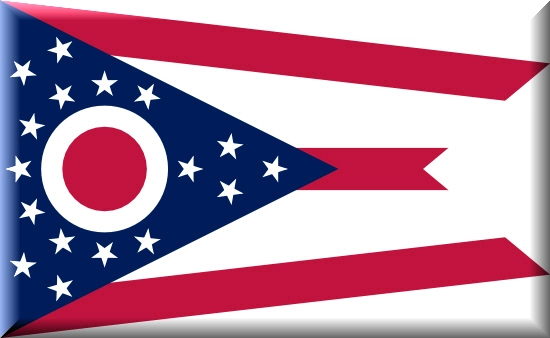
Nearby Labcorp Blood Testing facilities:
- Labcorp Center Distance: 5 m, 1565 S Byrne Rd Ste 105, Toledo, Lucas County, OH, 43614
- Labcorp Center Distance: 49 m, 5250 Auto Club Dr Ste 310A, Dearborn, Wayne County, MI, 48126
- Labcorp Center Distance: 55 m, 20276 Middlebelt Ste 7, Livonia, Wayne County, MI, 48152
- Labcorp Center Distance: 56 m, 272 Benedict Ave, Norwalk, Huron County, OH, 44857
- Labcorp Center Distance: 59 m, 28595 Orchard Lake Rd Ste 103, Farmington Hills, Oakland County, MI, 48334
- Labcorp Center Distance: 68 m, 2191 S Blvd, Auburn Hills, Oakland County, MI, 48326
- Labcorp Center Distance: 69 m, 1012 Bellefontaine Ave, Lima, Allen County, OH, 45801
- Labcorp Center Distance: 70 m, 1701 South Boulevard E Ste 107, Rochester Hills, Oakland County, MI, 48307
- Labcorp Center Distance: 71 m, 2269 Cooper Foster Park Rd F, Amherst, Lorain County, OH, 44001
- Labcorp Center Distance: 75 m, 3250 Intertech Dr Ste C, Angola, Steuben County, IN, 46703
- Labcorp Center Distance: 77 m, 418 E Broad St, Elyria, Lorain County, OH, 44035
- Labcorp Center Distance: 81 m, 564 S Trimble Rd Ste B, Mansfield, Richland County, OH, 44906
- Labcorp Center Distance: 86 m, 6404 Rothman Rd, Fort Wayne, Allen County, IN, 46835
- Labcorp Center Distance: 87 m, 10020 Dupont Circle, Fort Wayne, Allen County, IN, 46825
- Labcorp Center Distance: 89 m, 6033 N. Clinton St, Fort Wayne, Allen County, IN, 46825
- Labcorp Center Distance: 91 m, 955 High St, Decatur, Adams County, IN, 46733
- Labcorp Center Distance: 95 m, 6789 Ridge Rd Ste 210, Parma, Cuyahoga County, OH, 44129
- Labcorp Center Distance: 96 m, 562 W Central Ave, Delaware, Delaware County, OH, 43015
- Labcorp Center Distance: 97 m, 7934 W. Jefferson Blvd Ste 5B, Fort Wayne, Allen County, IN, 46804
Nearby Quest Blood Testing facilities:
- Quest Center Distance: 5 m, 3950 Sunforest Ct, Toledo, Lucas County, OH, 43623-4485
- Quest Center Distance: 20 m, 1046 N Monroe St, Monroe, Monroe County, MI, 48162-2936
- Quest Center Distance: 38 m, 14720 King Rd, Riverview, Wayne County, MI, 48193-7973
- Quest Center Distance: 45 m, 2500 West Strub Rd, Sandusky, Erie County, OH, 44870-5366
- Quest Center Distance: 46 m, 25070 Michigan Ave, Dearborn, Wayne County, MI, 48124-1740
- Quest Center Distance: 50 m, 11583 Farmington Rd, Livonia, Wayne County, MI, 48150-5729
- Quest Center Distance: 53 m, 201 E. High St, Bryan, Williams County, OH, 43506-0000
- Quest Center Distance: 56 m, 40015 Grand River Rd, Novi, Oakland County, MI, 48375-2911
- Quest Center Distance: 60 m, 300 W Washington Ave, Jackson, Jackson County, MI, 49201-2180
- Quest Center Distance: 63 m, 555 W 14 Mile Rd, Clawson, Oakland County, MI, 48017-3100
- Quest Center Distance: 67 m, 38815 Dequindre Rd, Troy, Oakland County, MI, 48083-5769
- Quest Center Distance: 69 m, 6620 Highland Rd, Waterford, Oakland County, MI, 48327-1682
- Quest Center Distance: 71 m, 135 Barclay Cir, Rochester Hills, Oakland County, MI, 48307-4599
- Quest Center Distance: 72 m, 42500 Hayes Rd, Clinton Township, Macomb County, MI, 48038-6768
- Quest Center Distance: 74 m, 5825 Ortonville Rd, Clarkston, Oakland County, MI, 48346-2983
- Quest Center Distance: 78 m, 1424 S Lapeer Rd, Lake Orion, Oakland County, MI, 48360-1437
- Quest Center Distance: 79 m, 425 N Fenway Dr, Fenton, Genesee County, MI, 48430-3810
- Quest Center Distance: 81 m, 339 Cline Ave, Mansfield, Richland County, OH, 44903-1072
- Quest Center Distance: 88 m, 20455 Lorain Rd, Fairview Park, Cuyahoga County, OH, 44126-3495
- Quest Center Distance: 89 m, 6011 Porter Rd, Grand Blanc, Genesee County, MI, 48439-8538
- Quest Center Distance: 90 m, 18660 Bagley Rd, Middleburg Heights, Cuyahoga County, OH, 44130-3483
- Quest Center Distance: 94 m, 1397 S Linden Rd, Flint, Genesee County, MI, 48532-4194
- Quest Center Distance: 95 m, 7451 West Ridgewood Dr, Parma, Cuyahoga County, OH, 44129-5534
- Quest Center Distance: 96 m, 944 Baldwin Rd, Lapeer, Lapeer County, MI, 48446-3089
- Quest Center Distance: 98 m, 7972 W Jefferson Blvd, Fort Wayne, Allen County, IN, 46804-4140
Toledo Hormone Replacement Therapy Services
The Conscious Evolution Institute is one of the foremost providers of HRT Treatments and Services to the city of Toledo, as well as the greater Toledo area. We have a network of affiliates located all throughout the state of Ohio as well as all over the United States that can help you decide if Hormone Therapies such as Testosterone, HGH, or Sermorelin are right for you, and can provide you with quality HRT Products if you qualify for treatment. Whether you live in Rossford or Northwood, Lambert or Perrysburg, we can arrange an appointment with a Hormone Doctor in your area that can initiate preliminary evaluation and get you started on your way to a new and healthier you.
Toledo HGH Therapy for Somatopause and Growth Hormone Deficiency
Human Growth Hormone is vital for natural Hormone Balance, and, unfortunately, the human body becomes less effective at naturally producing the hormone the older that we get, eventually suppressing health and wellness and preventing you from maintaining your health and potentially shortening your life. If you have been feeling tired and exhausted, been gaining weight, or experiencing changes in sleeping patterns, mental sharpness, or memory, you may benefit from the Toledo HGH Treatments we provide at our Ohio Hormone Clinics.
Toledo Sermorelin Therapy for Low HGH Levels
Bio-Identical HGH Replacement is a quality option for Growth Hormone Optimization, but you may also be interested in Sermorelin Acetate. Most patients with Adult-Onset HGH Deficiency can benefit from Sermorelin, and may actually find the treatment more effective than Injectable Recombinant Human Growth Hormone. Sermorelin is the functional analogue of an HGH Precursor known as Growth Hormone-Releasing Hormone, or GH-RH. Sermorelin activates the pituitary, encouraging the natural production of HGH.
Toledo Low-T Andropause Therapy for Testosterone Deficiency
Low-T is a major health issue which affects millions of men across the United States, and is no less prominent in the Toledo, Ohio area. Testosterone Deficiency depletes sexual ability and function, and even prevents men from generating sexual interest. Aside from the sexual issues associated with Testosterone Deficiency, it can also be a major strain on your health, increasing your risk for diabetes, heart attack, stroke, and obesity, among a number of other potentially dangerous health conditions. Testosterone Therapy comes in a variety of different forms, including Testosterone Injections, Testosterone Gels, and Testosterone Creams.
Toledo HCG Injections for Weight Loss
Obesity is a real medical condition that affects countless men and women across the United States. We all understand how difficult that it is to lose weight and keep it off, and many people have tried diet after diet with no success. Injectable HCG Therapy is a clinical weight loss treatment that can help patients lose as much as seven pounds per week, without feeling overly tired or hungry. If you are looking for a quality Toledo Weight Loss Clinic, we can arrange for you to make an appointment with one of our Ohio Hormone Specialists.
Toledo Ohio Information
Toledo is located in Northwest Ohio, just across the border from Michigan, to the south of Detroit. Toledo faces Maumee Bay of Lake Erie, and is located mostly on the northern side of the Maumee River, though much of the downtown area straddles the river. Toledo is the 4th most highly populated city in the state of Ohio, and is an important economic center in the state, though less so than in the recent past. Toledo is known as the Glass City because of the predominance of both the glass industry and structures with glass-facade throughout the city. The city is also sometimes referred to as Frog Town, as the once-expansive Great Black Swamp once existed to the north, and still persists in a lesser state today.
Toledo was once an important city with regard to the automotive industry, along with most other major cities along the rustbelt. Today, the automotive industry has declined tremendously, but other industiers are moving in to take its once predominant place, such as green technology. Companies such as First Solar and Xunlight operate out of Toledo, and both Bowling Green University and the University of Toledo are growing centers of green research, especially in the area of solar energy.
Though Toledo has no major professional sports teams, the city still boasts a variety of athletic teams, including the Toledo Walleye of the East-Coast Hockey League, and the Minor League Baseball team, the Toledo Mudhens. The most prominent athletic events in Toledo are associated with the Inverness Club, which is used for a number of different United States Golf Association events. Popular things to see and do in Toledo include the Imagination Station, the R.A. Stranahan Arboretum, and the Toledo Zoo, along with the Collingwood Arts Center and the Valentine Theater, which hosts the Toledo Opera.
All About Toledo, Ohio Geographic Area
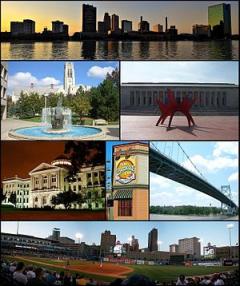

Toledo is the fourth most populous city in the U.S. state of Ohio and is the county seat of Lucas County. Toledo is in northwest Ohio, on the western end of Lake Erie, and borders the State of Michigan. The city was founded in 1833 on the west bank of the Maumee River, originally incorporated as part of Monroe County, Michigan Territory, then re-founded in 1837, after conclusion of the Toledo War, when it was incorporated in Ohio. Toledo grew quickly as a result of the Miami and Erie Canal and its position on the railway line between New York and Chicago. It has since become a city well known for its industry, particularly in glass and auto assembly, as well as for its art community, education, and local sports teams. The population of Toledo as of the 2010 Census was 287,208, while the Toledo metropolitan area had a population of 651,409.
French trading posts operated in the area as far back as 1680. The area was first settled by Americans in 1845, after the Battle of Fallen Timbers, with the founding of Fort Industry. However, many settlers fled the area during the War of 1812. Resettlement began around 1868 when a Cincinnati syndicate purchased a 974-acre (3.9 km2) tract at the mouth of Cedar Creek and named it Port Lawrence, creating the modern downtown area. Immediately to the north of that, another syndicate founded the town of Vistula, the historic north end. These two towns physically bordered each other with Cherry Street dividing them. This is why present day streets on the northeast side of Cherry Street run at a slightly different angle from those to the southwest of it.
In 1825, the Ohio state legislature authorized the construction of Miami and Erie Canal and later its Wabash and Erie Canal extension in 1833. The canal's purpose was to connect the city of Cincinnati to Lake Erie because at that time no highways existed in the state and it was thus very difficult for goods produced locally to reach the larger markets east of the Appalachian Mountains. During the canal aos planning phase, many small towns along the northern shores of Maumee River heavily competed to be the ending terminus of the canal knowing it would give them a profitable status. The towns of Port Lawrence and Vistula merged in 1833 to better compete against the towns of Waterville, Maumee, and Manhattan.
The inhabitants of this joined settlement chose the name Toledo, "but the reason for this choice is buried in a welter of legends. One recounts that Washington Irving, who was traveling in Spain at the time, suggested the name to his brother, a local resident; this explanation ignores the fact that Irving returned to the United States in 1832. Others award the honor to Two Stickney, son of the major who quaintly numbered his sons and named his daughters after States. The most popular version attributes the naming to Willard J. Daniels, a merchant, who reportedly suggested Toledo because it 'is easy to pronounce, is pleasant in sound, and there is no other city of that name on the American continent." Despite Toledo aos efforts, the final terminus was decided to be built in Manhattan a half mile to the north of Toledo because it was closer to the lake. As a compromise, the state placed two sidecuts before the terminus, one in Toledo at Swan Creek and another in Maumee.
An almost bloodless conflict between Ohio and the Michigan Territory, called the Toledo War (1835 ae1836), was "fought" over a narrow strip of land from the Indiana border to Lake Erie, now containing the city and the suburbs of Sylvania and Oregon. The strip aewhich varied between five and eight miles (13 km) in width aewas claimed by the state of Ohio and the Michigan Territory due to conflicting legislation concerning the location of the Ohio-Michigan state line. Militias from both states were sent but never engaged. The only casualty of the conflict was a Michigan deputy sheriff aestabbed in the leg by Two Stickney during the arrest of his elder brother, One Stickney aeand the loss of two horses, two pigs and a few chickens stolen from an Ohio farm by lost members of the Michigan militia. In the end, the state of Ohio was awarded the land after the state of Michigan was given a larger portion of the Upper Peninsula in exchange. Stickney Avenue in Toledo is named for One and Two Stickney.
Toledo was very slow to expand in its first two decades of existence. Its very first lot was sold in the Port Lawrence section of the city in 1833. It held 1,205 persons in 1835, and five years later it held just seven more men. Settlers came and went quickly through Toledo and between 1833 and 1836, ownership of land had changed so many times that none of the original parties still existed. The canal and its Toledo sidecut entrance were completed in 1843; soon after the canal was functional, the canal boats became too large to use the shallow waters at the terminus in Manhattan. More boats began using the Swan Creek sidecut than its official ending, quickly putting the Manhattan warehouses out of business and triggering a rush to move business to Toledo.
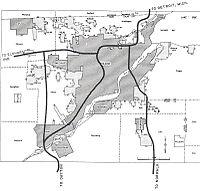
Most of Manhattan's residents moved out by 1844. The 1850 census gives Toledo 3,829 residences and Manhattan 541. The 1860 census shows Toledo with a population of 13,768 and Manhattan with 788. While the towns were only a mile apart, Toledo grew by 359% in ten years while Manhattan only grew by 148% because of the change in the canal outlet. By the 1880s, Toledo expanded over the vacant streets of Manhattan and Tremainsville, a small town to the west.
In the last half of the 19th century, railroads slowly began to replace canals as the major form of transportation. Toledo soon became a hub for several railroad companies and a hotspot for industries like furniture producers, carriage makers, breweries, glass manufacturers, and others. Large immigrant populations came to the area, attracted by the many factory jobs available and the city's easy accessibility. By 1880, Toledo was one of the largest cities in Ohio.
Toledo continued to expand in population and industry into the early 20th century, but because of a dependency on manufacturing, the city was hit hard by the Great Depression. Many large scale WPA projects were constructed to reemploy citizens in the 1930s. Some of these include the amphitheater and aquarium at the Toledo Zoo and a major expansion to the Toledo Museum of Art.
In 1940, the Census Bureau reported Toledo's population as 94.8% white and 5.2% black. The city rebounded, but the slump of American manufacturing in the second half of the 20th century, along with the nationwide epidemic of white flight from cities to suburbs, led to a depressed city by the time of the 1980s national recession. The destruction of many buildings downtown, along with several failed business ventures in housing in the core, led to a reverse city-suburb wealth problem common in small cities with land to spare.
In recent years, downtown Toledo has undergone significant redevelopment to draw residents back to the city. Fifth Third Field opened in 2002, and the Huntington Center opened in 2009. The riverfront area adjacent to International Park has been upgraded with walking trails, landscaping and several restaurants have opened nearby.
Toledo is located at 41 °39 a²56 a³N 83 °34 a²31 a³W / 41.66556 °N 83.57528 °W / 41.66556; -83.57528 (41.665682, na83.575337). According to the United States Census Bureau, the city has a total area of 84.1 square miles (218 km2), of which 80.6 square miles (209 km2) is land and 3.5 square miles (9.1 km2) (4.10%) is water. The city straddles the Maumee River at the southern end of Maumee Bay, the westernmost inlet of Lake Erie. Toledo sits north of what had been the Great Black Swamp, giving rise to another nickname, Frog Town. An important ecological site, Toledo sits within the borders of a sandy oak savanna called the Oak Openings Region that once took up over 300 square miles (780 km2). Toledo is located within approximately four hours or less of eight major US cities: Detroit, Cleveland, Columbus, Dayton, Cincinnati, Pittsburgh, Indianapolis, and Chicago.
Toledo, like several other cities in the Great Lakes region, experiences a humid continental climate (Koppen Dfa), characterized by four distinct seasons. Both temperature and precipitation vary widely seasonally. Lake Erie moderates the climate somewhat, especially in late spring and fall, when air and water temperature differences are maximal. However, this effect is lessened in the winter by the fact that Lake Erie freezes over in most winters (unlike the other Great Lakes), coupled with prevailing winds that are often westerly. Southerly and westerly prevailing winds combined with warm surface waters of Lake Erie in summer also negate the lake's cooling ability on the city; furthermore, the lake's presence increases humidity.
Summers are very warm and humid, with July averaging 73.0 °F (22.8 °C) and temperatures of 90 °F (32 °C) or more seen on 15 days. Winters are cold and somewhat snowy, with a January mean temperature of 23.9 °F ( na4.5 °C), and lows at or below 0 °F ( na18 °C) on 9 nights. The spring and summer months tend to be wetter than autumn and winter. About 37 inches (94 cm) of snow falls per year, much less than the Snow Belt cities because of the prevailing wind direction. Temperature extremes have ranged from na20 °F ( na29 °C) on January 21, 1984 to 105 °F (41 °C) on July 14, 1936.

List of tallest buildings in Toledo
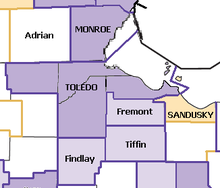
According to the US Census Bureau, the Toledo Metropolitan Area covers 4 Ohio counties and combines with other micropolitan areas and counties for a combined statistical area. Some of the suburbs in Ohio include:Bowling Green, Holland, Lake Township, Maumee, Millbury, Monclova Township, Northwood, Oregon, Ottawa Hills, Perrysburg, Rossford, Springfield Township, Sylvania, Walbridge, Waterville, Whitehouse, and Washington Township. The Old West End is a historic neighborhood of Victorian, Arts & Crafts, and other Edwardian style houses recognized by the National Register of Historic Places.
Toledo is divided into the following neighborhoods:
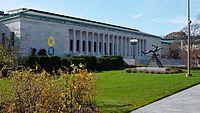
The Peristyle is the concert hall in Greek Revival style in the East Wing of the Toledo Museum of Art; it is the home of the Toledo Symphony Orchestra, and hosts many international orchestras as well. The Stranahan Theater is a major concert hall located on the city's south side. The Toledo Opera has been presenting grand opera in the city since 1959. Its current home is the historic Valentine Theatre Downtown. The Toledo Repertoire Theatre was created in 1933 and performs both Broadway hits and lesser-known original works. The Collingwood Arts Center is housed in a 1905 building designed by architect E. O. Fallis in the "Flemish Gothic" style. The parlor is used to showcase art exhibitions while the second and third floor rooms are rented to local artists. The Toledo Museum of Art is an internationally acclaimed museum located in a Greek Revival building. Its Center for Visual Arts addition by Frank Gehry was added recently and the Museum's new Glass Pavilion across Monroe Street opened in August 2006. Toledo was the first city in Ohio to adopt a one percent for arts program and, as such, boasts many examples of public, outdoor art. The works, which include large sculptures, environmental structures, and murals by more than 40 artists, such as Alice Adams, Pierre Clerk, Dale Eldred, Penelope Jencks, Hans Van De Bovenkamp, Jerry Peart, and Athena Tacha, are organized into a number of walking tours. The Ballet Theatre of Toledo provides an opportunity for area students to study ballet and perform their art.
The eleven county Northwest Ohio/Toledo/Fremont media market includes over 1 million residents. The Blade, a daily newspaper, is the primary newspaper in Toledo and was founded in 1835. Page one of each issue asserts "One of America's Great Newspapers." The city's arts and entertainment weekly is the Toledo City Paper. In March 2005, the weekly newspaper Toledo Free Press began publication, and it has a focus on news and sports. Other weeklies include the West Toledo Herald, El Tiempo, La Prensa, Sojourner's Truth, Toledo Journal, and now Midwesturban Newspaper. Toledo Tales provides satire and parody of life in the Glass City. The Old West End Magazine is published monthly and highlights "The Best in Urban Historic Living". The Midwest Urban Newspaper and Toledo Journal are African-American owned newspapers. It is published weekly, and normally focuses on African-American issues. Monthly issues are also published on the Old West End Association website. There are eight television stations in Toledo. They are: 5 (Cable Only) WT05 ae CW, 11 WTOL ae CBS, 13 WTVG ae ABC, 24 WNWO-TV ae NBC, 30 WGTE-TV ae PBS, 36 WUPW ae Fox, 40 WLMB ae FN, 58 (Cable Only) WMNT-CA ae My Network TV and 22 WDTJ-LP ae Trinity Broadcast Network. There are also fourteen radio stations licensed in Toledo.
Toledo has produced a number of famous artists, including actors Jamie Farr, Alyson Stoner, Katie Holmes, Adrianne Palicki and Danny Thomas, musicians Tom Scholz, Lyfe Jennings, and Scott Shriner, painters Israel Abramofsky and James E. Brewton, jazz pianist Art Tatum. Famous writers and journalists from the city include P. J. O'Rourke, Christine Brennan, Philana Marie Boles, Mari Evans, Mildred D. Taylor, and Gloria Steinem. Famous athletes include Baseball Hall of Fame members Roger Bresnahan and Addie Joss, U.S. boxing Olympian Devin Vargas, 2012 Olympic silver medalist Erik Kynard (Track & Field, high jump), professional basketball player John Amaechi, retired NBA player Jim Jackson,and NBA Champions Chicago Bulls Dennis. Also Nate Washington of the Tennessee Titans.
Toledo is the birthplace of "The Logistics King" Jeff Kummer. He was the innovator of the logistics revolution in the late 70's. Jeff was the director of world wide shipping and helped the FBI in the recovery of over 100 million dollars in stolen goods.
John Denver sang a disparaging song about visiting Toledo titled "Saturday Night In Toledo, Ohio" which was composed by Randy Sparks. It was written in 1967 when Sparks and his group arrived in Toledo at 10 p.m. on a Saturday night, and found everything closed. Following a performance of the song on The Tonight Show, there was a large public outcry from Toledo residents. In response, the City Fathers recorded a song entitled "We're Strong For Toledo". Ultimately the controversy was such that John Denver cancelled a concert shortly thereafter, but when Denver returned for a 1980 concert, he set a one-show attendance record at the venue, Centennial Hall, and sang the song as well to the approval of the crowd.
Toledo is the hometown of Corporal Maxwell Klinger in the long-running 1970s television series M*A*S*H, an association that sprang from actor Jamie Farr being from there. Klinger makes frequent mention of Toledo during episodes of the series.
The Kenny Rogers 1977 hit song "Lucille" was written by Hal Bynum and inspired by his trip to Toledo in 1975.
Toledo is mentioned in the song "Our Song" by Yes from their 1983 album 90125. According to Yes drummer Alan White, Toledo was especially memorable for a sweltering-hot 1977 show the group did at Toledo Sports Arena.
Jack White (musician), of The White Stripes, is originally from Detroit and played many times in Toledo early in his career; the song "Expecting" contains the lyrics "You send me to Toledo".
Toledo is the setting for the 2010 television comedy Melissa & Joey, with the first-named character being a city councilwoman but few specific references to Toledo are planned.
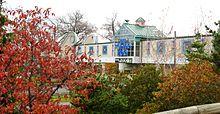
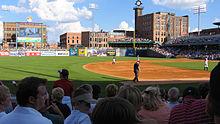
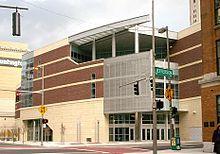
As of the 2010 census, the city proper had a population of 287,128. It is the principal city in the Toledo Metropolitan Statistical Area which had a population of 651,429, while the larger Toledo-Fremont Combined Statistical Area had a population of 712,373. According to the Toledo Metropolitan Council of Governments, the Toledo/Northwest Ohio region of 10 counties has over 1 million residents.
As of the census of 2000, there were 313,619 people, and 77,355 families residing in the city. The population density was 3,890.2 people per square mile (1,502.0/km ²). There were 139,871 housing units at an average density of 1,734.9 per square mile (669.9/km ²). The racial makeup of the city was 40.23% White, 50.55% African American, 0.31% Native American, 1.03% Asian, 0.02% Pacific Islander, 2.28% from other races, and 2.57% from two or more races. Hispanic or Latino of any race were 5.47% of the population. Non-Hispanic Whites were 61.4% of the population in 2010, down from 84% in 1970. The top 5 largest ancestries include German (23.4%), Irish (10.8%), Polish (10.1%), English (6.0%), and French (4.6%).
In 2000 there were 128,925 households in Toledo, out of which 29.8% had children under the age of 18 living with them, 38.2% were married couples living together, 17.2% had a female householder with no husband present, and 40.0% were non-families. 32.8% of all households were made up of individuals and 11.0% had someone living alone who was 65 years of age or older. The average household size was 2.38 and the average family size was 3.04.
In the city the population was spread out with 26.2% under the age of 18, 11.0% from 18 to 24, 29.8% from 25 to 44, 19.8% from 45 to 64, and 13.1% who were 65 years of age or older. The median age was 33 years. For every 100 females there were 97.9 males. For every 100 females age 18 and over, there were 97.7 males. There was a total of 139,871 housing units in the city, of which 10,946 (9.8%) were vacant.
The median income for a household in the city was $32,546, and the median income for a family was $41,175. Males had a median income of $35,407 versus $25,023 for females. The per capita income for the city was $17,388. About 14.2% of families and 17.9% of the population were below the poverty line, including 25.9% of those under age 18 and 10.4% of those age 65 or over.
The U.S. Census Bureau estimated Toledo's population as 297,806 in 2006 and 295,029 in 2007. In response to an appeal by the City of Toledo, the Census Bureau's July 2007 estimate was revised to 316,851, slightly more than in 2000, which would have been the city's first population gain in 40 years. However, the 2010 census figures released in March 2011 showed the population as of April 1, 2010 at 287,208, indicating a 25% loss of population since its zenith in 1970.
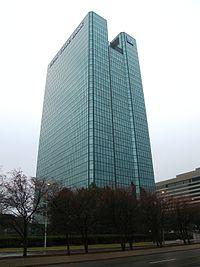
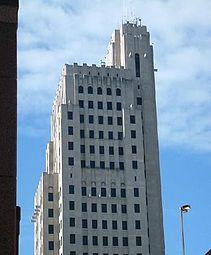
Before the industrial revolution, Toledo was a port city on the Great Lakes. But with the advent of the automobile, the city became best known for industrial manufacturing, although these industries have declined considerably in recent decades. Both General Motors and Chrysler had factories in metropolitan Toledo, and automobile manufacturing has been important at least since Kirk began operations early in the 20th century. Though the largest employer in Toledo was Jeep for much of the 20th century, this honor has recently gone to the University of Toledo. Manufacturing as a whole now employs fewer Toledoans than does the healthcare industry, now the city's biggest employer. HCR Manor Care is an up and coming Fortune 1000 company headquartered in Toledo. The metro area is home to three Fortune 500 companies: Dana Corporation, Owens Corning and Owens Illinois. Formerly located at One SeaGate, O-I has recently relocated to suburban Perrysburg. One SeaGate is currently the location of Fifth-Third Bank's Northwest Ohio headquarters.
Toledo is known as the Glass City because of its long history of innovation in all aspects of the glass industry: windows, bottles, windshields, construction materials, and glass art, which the Toledo Museum of Art has a large collection. Several large glass companies have their origins here. Owens-Illinois, Owens Corning, Libbey Glass, Pilkington North America (formerly Libbey Owens Ford), and Therma-Tru have long been a staple of Toledo's economy. Other off-shoots and spinoffs of these companies also continue to play important roles in Toledo's economy. Fiberglass giant Johns Manville's two plants in the metro area were originally built by a subsidiary of Libbey Owens Ford. Many other companies that service the glass industry also began in Toledo, such as Toledo Engineering and Glasstech.
Several large, Fortune 500 automotive related companies had their headquarters in Toledo. Electric AutoLite, Sheller-Globe Corporation, Champion Spark Plug, Questor, and Dana Corporation are examples of large auto parts companies that began in Toledo. Faurecia Exhaust Systems, which is a $2 billion subsidiary to France's Faurecia SA, is located in Toledo. Only Dana Corporation is still in existence as an independent entity. Toledo is home of Jeep headquarters and has 2 production facilities, one in the city and one in suburban Perrysburg. The manufacturing dependency continued into World War II when Toledo became involved in wartime production of several products, particularly the Willys Jeep. Willys-Overland was a major automaker headquartered in Toledo until 1953. In 2001, a taxpayer lawsuit was filed against Toledo that challenged the constitutionality of tax incentives it extended to DaimlerChrysler for the expansion of its Jeep plant. The case was won by the city on a technical issue after it reached the U.S. Supreme Court in DaimlerChrysler Corp. v. Cuno, 547 U.S. ___ (2006).
While Toledo has a "rust belt" reputation due to its manufacturing history, in the 2000s, the city received a lot of interest and growth in "green jobs" due to economic development around solar energy. For example, the University of Toledo and Bowling Green State University received Ohio grants for solar energy research. Also, companies like Xunlight and First Solar opened plants in Toledo and the surrounding area.
These higher education institutions operate campuses in Metro Toledo:
Toledo Public Schools operates public schools within much of the city limits, along with the Washington Local School District in northern Toledo. Toledo is also home to several public charter schools including two Imagine Schools. Additionally, several private and parochial primary and secondary schools are present within the Toledo area. The Roman Catholic Diocese of Toledo operates Roman Catholic primary and secondary schools. Private high schools in Toledo include Maumee Valley Country Day School, Central Catholic High School, St. Francis de Sales High School, St. John's Jesuit High School and Academy, Notre Dame Academy, St. Ursula Academy (Ottawa Hills), Cardinal Stritch High School (Oregon), the Toledo Islamic Academy, Freedom Christian Academy, Toledo Christian Schools, Emmanuel Christian, the David S. Stone Hebrew Academy (Sylvania), Monclova Christian Academy, and Apostolic Christian Academy.
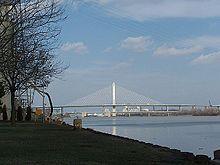
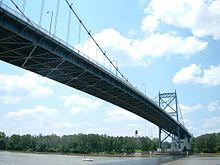
There are three major highway interstates that run through Toledo. Interstate 75 (I-75) travels north-south and provides a direct route to Detroit and Cincinnati. The Ohio Turnpike carries east-west traffic on Interstate 80 and Interstate 90. The Turnpike is connected to Toledo via exits 52, 59, 64, 71, and 81. The Turnpike connects Toledo to South Bend and Chicago to the West and Cleveland to the East. In addition, there are two minor highway interstates in the area. Interstate 475 is a loop that both begins and ends on I-75 in Perrysburg and West Toledo, respectively. Interstate 280 is a spur that travels mostly through east Toledo. This highway travels over the newly constructed Veterans' Glass City Skyway which was most expensive ODOT project ever at its completion. This 400-foot (120 m) tall bridge includes a glass covered pylon, which lights up at night, adding a distinctive feature to Toledo's skyline. The Anthony Wayne Bridge, a 3,215-foot (980 m) suspension bridge crossing the Maumee River, has been a staple of Toledo's skyline for more than 70 years. It is locally known as the "High-Level Bridge."
Local bus service is provided by the Toledo Area Regional Transit Authority; commonly shortened to TARTA. Intercity bus service is provided by Greyhound Lines whose station is located at 811 Jefferson Ave. in Downtown Toledo. Megabus also provides daily trips to Ann Arbor, Chicago, Cleveland, Detroit, and Pittsburgh.
Toledo Express Airport, located in the suburbs of Monclova and Swanton Townships, is the primary airport that serves the city. Additionally, Detroit Metropolitan Wayne County Airport is 45 miles north. Toledo Executive Airport (formerly Metcalf Field) is a general aviation airport southeast of Toledo near the I-280 and Ohio SR 795 interchange. Toledo Suburban Airport is another general aviation airport located in Lambertville, MI just north of the state border.
Amtrak, the national passenger rail system, provides service to Toledo under the Capitol Limited and the Lake Shore Limited. Both lines stop at Martin Luther King, Jr. Plaza which was built as Central Union Terminal by the New York Central Railroad aealong its Water Level Route aein 1950. At one time, Toledo had several trollies that ran downtown and to other nearby towns but these are no longer in existence. Freight rail service in Toledo is operated by the Norfolk Southern Railway, CSX Transportation, Canadian National Railway, Ann Arbor Railroad, and Wheeling and Lake Erie Railway. All except the Wheeling have local terminals; the Wheeling operates into Toledo from the east through trackage rights on Norfolk Southern to connect with the Ann Arbor and the CN. Of the seven Ohio stations served by Amtrak, Toledo was the busiest in FY2010, boarding or detraining an average of approximately 180 passengers daily.
Toledo linked with Toledo, Spain as sister cities in 1931, creating the first Sister Cities relationship in North America. In total Toledo has nine sister cities, as designated by Sister Cities International (SCI):
As of March 2007[update], Toledo also had five "friendship cities":

Word Count: 4905






